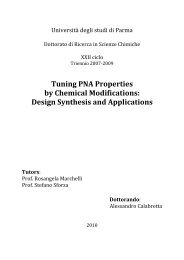Create successful ePaper yourself
Turn your PDF publications into a flip-book with our unique Google optimized e-Paper software.
Int Arch Occup Environ Health (2008) 81:487–493 489<br />
means of alpha-amylase detection (InWnity amylase<br />
reagent; Sigma, Milan, Italy). Alpha-amylase was never<br />
detected and none of the samples was excluded. The EBC<br />
samples were stored at ¡80°C until analysis.<br />
Detection of urine and EBC Cr<br />
Urinary Cr (Cr-U) was measured by means of electrothermal<br />
atomic absorption spectrometry (ETAAS) with Zeeman<br />
eVect background correction, using a 1/10 5 dilution of<br />
a certiWed standard control (1 g/l) in water (Fluka) for every<br />
ten samples and conWrmed by inductively coupled plasma<br />
mass spectrometry (ICP-MS) in a separate laboratory.<br />
Finally, the ETAAS method was validated using a lyophilised<br />
urine control (Clincheck®, Recipe, Germany,<br />
Cr = 7.5 g/L). The limit of detection (LOD) was 0.05 g/l.<br />
Cr was normalised for urinary creatinine content (all the<br />
samples were between 30 and 300 mg% of creatinine), and<br />
therefore expressed as g/g creatinine. No samples of<br />
NSCLC patients were below the LOD and in the statistical<br />
analysis no data were censored.<br />
EBC Cr (Cr-EBC) was measured by means of ETAAS,<br />
as previously described (Caglieri et al. 2006), and con-<br />
Wrmed by inductively coupled plasma mass spectrometry<br />
(ICP-MS) in a separate laboratory. The LOD was 0.05 g/l.<br />
No samples of NSCLC patients were below the LOD and in<br />
the statistical analysis no data were censored. Unfortunately,<br />
in most EBC samples, Cr was too low to be speciated<br />
with the method proposed by Goldoni et al. 2006 and<br />
no more sensitive methods are present in literature.<br />
Detection of tissue Cr<br />
Three small pieces of non-cancerous lung tissue that had<br />
not been in direct contact with the surgical instruments<br />
were collected from each NSCLC patient. The tumour<br />
resection involved the upper lobe in 13 patients and the<br />
lower lobe in 7 patients. Portions of cancerous and noncancerous<br />
lung tissue pieces derived from the parenchyma<br />
were ablated. It is important to note that tissue pieces<br />
weighed, in general, a few grams and cut signs were evident<br />
on them. Therefore, small pieces where Cr was dosed<br />
(about 30–50 mg each) were in the opposite part of the cut.<br />
Samples were immediately stored at ¡80°C and Cr analysis<br />
was performed a few days later. A partial conWrmation of<br />
contamination avoidance was that Cr was similar in the<br />
several small pieces of tissue from the same patient (data<br />
not shown).<br />
Samples were boiled at 90°C overnight in order to eliminate<br />
their water content. The dry tissue was weighed and<br />
digested for 3 h with a solution containing 1,250 l of<br />
water and 1,250 l of nitric acid (69%) at 65°C. Cr was<br />
measured by means of ETAAS using certiWed standard<br />
controls (Fluka, Milan, Italy) for every ten samples after<br />
appropriate dilution to minimise the eVect of Cr contamination<br />
due to the use of nitric acid. The LOD was 0.05 g/l,<br />
but the concentrations were expressed as g/g dry tissue.<br />
The measurement was also repeated using a piece of cancerous<br />
tissue. No samples were below the LOD and in the<br />
statistical analysis no data were censored.<br />
Detection of Cr in surgical instruments<br />
Surgical clips were incubated for 3 h in an aqueous solution,<br />
alone or attached to the plastic tube of the EBC collection<br />
system, as were the standard linear cutter and head of<br />
the endosurgery machine. Cr was directly measured in the<br />
water used for washing and expressed as ng/clip for the<br />
clips, and g/g for the other surgical instruments.<br />
Statistical analysis<br />
For the controls, a value of 0.025 g/l was assigned, if Cr<br />
was below the LOD in urine or EBC. The non-parametric<br />
Shapiro–Wilk’s statistical test was used because of the nonnormal<br />
nature of the data, which were expressed as median<br />
values with interquartile ranges. Paired samples were compared<br />
using Wilcoxon’s test for repeated measures and the<br />
Mann–Whitney test for independent samples. For the linear<br />
regression analysis, we used Pearson’s correlation coeYcient<br />
on a log–log scale in order to avoid heteroscedasticity<br />
and to normalise standardised residuals. P values of 0.05 or<br />
less were considered statistically signiWcant.<br />
Results<br />
As there was neither diVerence in the EBC volume between<br />
the controls and NSCLC patients at either collection time nor<br />
any correlation between EBC volume and the levels of the<br />
measured transition elements in EBC (data not shown), total<br />
EBC volume was not considered in the statistical analysis.<br />
Moreover, no diVerences in the EBC volume were observed<br />
before and after the surgical intervention (data not shown).<br />
Table 2 shows the Cr-EBC and Cr-U levels. There was<br />
no diVerence between the NSCLC patients and controls at<br />
time 1, but there was a signiWcant increase in Cr-EBC of<br />
the patients at time 2 in comparison with time 1 (P < 0.05)<br />
and in comparison with the controls (P < 0.05). There was<br />
also a similar increase in the Cr-U levels (P < 0.01 vs time<br />
1 and controls).<br />
The level of Cr was 0.14 (0.04–0.24) g/g in normal pulmonary<br />
tissue and 0.14 (0.06–0.3) g/g in cancerous tissue<br />
(P =ns).<br />
Surgical clips released only a small amount of Cr [0.03<br />
(0.02–0.04) ng/clip], but the linear cutter and the head of<br />
123
















